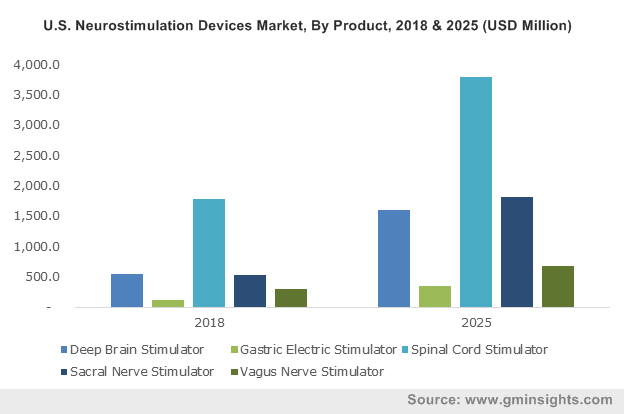Neurostimulation devices market to register double-digit CAGR over 2017-2024, seep brain stimulators to garner increased prominence
Publisher : Fractovia | Published Date : 2016-06-16Request Sample
As the awareness about the massive burden levied by untreated neurological disorders has risen, neurostimulation devices market has gained significant traction lately. The Global Burden of Disease, a study conducted by the World Health Organization in collaboration with the World Bank and the Harvard School of Public Health, elucidated the effects of neurological disorders and other chronic conditions to the international medical community. The study also pointed out the fact that traditional health statistics had so long accounted for only the mortality rate caused by neurological disorders while the disability rate has been largely overlooked. With increased human life expectancy and neurological disorder occurrence in the global geriatric population, neurostimulation devices market trends are likely to witness commendable momentum in the years ahead.
Germany Neurostimulation devices Market, By Product, 2013 - 2024

With increased awareness about myriad neurological disorders, an appreciable amount of innovation has plagued neurostimulation devices industry, driving the vertical to record $5.4 billion in 2016. Speaking of innovations, it is noteworthy to mention that recently, an Israeli company Neurolief developed a non-invasive migraine treating device that is looking to compete in the present neurostimulation devices industry, largely dominated by invasive surgery involving implants in the brain for managing extreme migraine. This device is anticipated to have positive results for migraine sufferers who often have to rely on drugs with chronic side effects. Nuerolief has already raised $5 million in series A funding and is expected to add a new horizon to neurostimulation devices market outlook, as the device procures marketing clearances in Europe, USA, and Israel.
Similar to Neurolief, another company, Battelle, touted its experimental NeuroLife system that has been designed to restore upper body functions after a paralysis. NeuroLife uses a microchip implanted in the brain, deep machine learning, custom built algorithms and specially designed sleeves to stimulate the arms and assist patients to move their limbs with the help of thoughts. The system has not yet been manufactured for the masses and is still being worked upon to generate precise force necessary in everyday functionality.
Incidentally, researchers had been steadily working over the past three years to enable users to grade their muscle contractions to handle delicate objects. This has resulted in the device being able to achieve sophisticated and precise movements of individual fingers. The incidence demonstrates the ability of brain computer interface technology to eliminate human disabilities. Presuming that manufacturers would succeed in bringing the device to the mainstream, it is undeniable that neurostimulation devices market size would soar heights over 2017-2024.
As per the Parkinson’s Foundation, more than 10 million people are estimated to be suffering from Parkinson’s disease. In this regard, research programs in the deep brain stimulation for Parkinson’s disease management has helped in developing new technologies that will not only deliver neurostimulation but also change with the patient’s needs. Currently, a device developed by researchers at University of California called Medtronic with an extra electronic circuit has been found to substantially change the present condition of stimulators used to control the symptoms of Parkinson’s disease. R&D programs such as the aforementioned and the rising significance of deep brain stimulators are certain to change neurostimulation devices industry trends over 2017-2024.
The last couple of decades have witnessed the healthcare community trying to find ways for successful pain management without the need of addictive painkillers – a trend that has successfully augmented neurostimulation devices market growth. Drug developers who have been trying to come up with non-addictive pain medications in fact, are facing steep competition from neurostimulation devices market players who have been increasingly coming up with smaller and more comfortable devices that are in the least intrusive and do not involve the risk and complication of surgery.
Speaking of painkillers, between 1999 and 2015, a survey conducted in the United States by the Centers for Disease Control and Prevention, showed that the number of opioids prescribed has been tripled, however, the pain levels in Americans remained the same. On the other hand, an estimated 2 million people in the U.S. abused prescription pain medication during 2015. Incidentally, the U.S. neurostimulation devices market accounted for largest share in North America in 2016, driven by a plethora of modern solutions for neurological disorders.
As the use of opioids and the concern regarding their side effects and addictiveness is increasing, the medical community is gradually shifting its focus to developing non-addictive pain relivers and drug free alternatives like neurostimulation devices. These devices can also alleviate withdrawal symptoms in people who are already addicted to opioids. On these grounds, it would be fair to state that the future looks promising for neurostimulation devices market. As per estimates, neurostimulation devices industry size will exceed $16 billion by 2024.